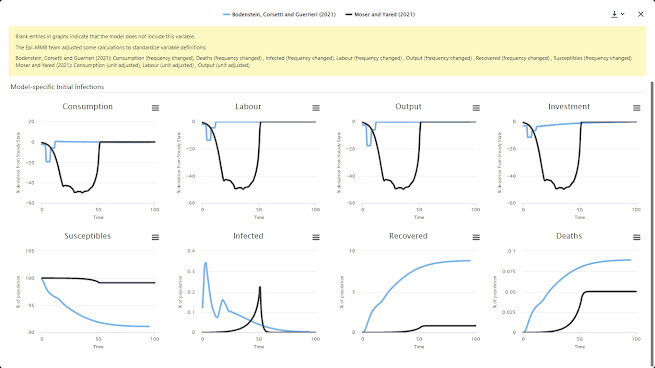One-way or a two-way interaction model?
Why is it interesting?
The interaction between the epidemic and the macro economy can be modelled in different ways. This comparison shows the main differences between a one-way and a two-way interaction epidemic macro model. In the one-way interaction model (Atkeson 2020), the epidemic has an impact on the economy but agents cannot influence the evolution of the epidemic through their decisions. In contrast, the Eichenbaum, Rebelo and Trabandt (2021) model features a two-way interaction between the epidemic and the macro economy.
What to do on the Epi-MMB?
Models: ERT_21_Epi, A_20
Shocks: Initial infections of 0.1% of the population
Variables: Susceptibles, Infected, Recovered
What is interesting?
The impulse responses to an initial infections shock where 0.1 percent of the population gets infected significantly differ for the two models. In the ERT_21_Epi model, agents decide to cut back consumption and hours worked to mitigate the risk of becoming infected. Omitting this motive in the model leads to a much faster and more severe spread of the virus. The infection curve is significantly flatter in the two-way interaction model, suggesting that the epidemic will last longer but will also be milder. The number of recovered and deceased people* is consequently also much higher in the A_20 model with almost 90 percent of the population, compared to approximately 54 percent in ERT_21_Epi.
Most models on the Epi-MMB implement a two-way interaction between the epidemic and the macro economy, as this provides greater scope for additional research, for example, regarding optimal policy responses.
*The A_20 model only reports the sum of recovered and deceased people, which can be seen in the chart. Since the number of deaths is relatively small in the ERT_21_Epi model, it does not make much of a difference for the illustration.
Reference: Eichenbaum, Rebelo and Trabandt (2021), Atkeson (2020)

Comments
Post a Comment